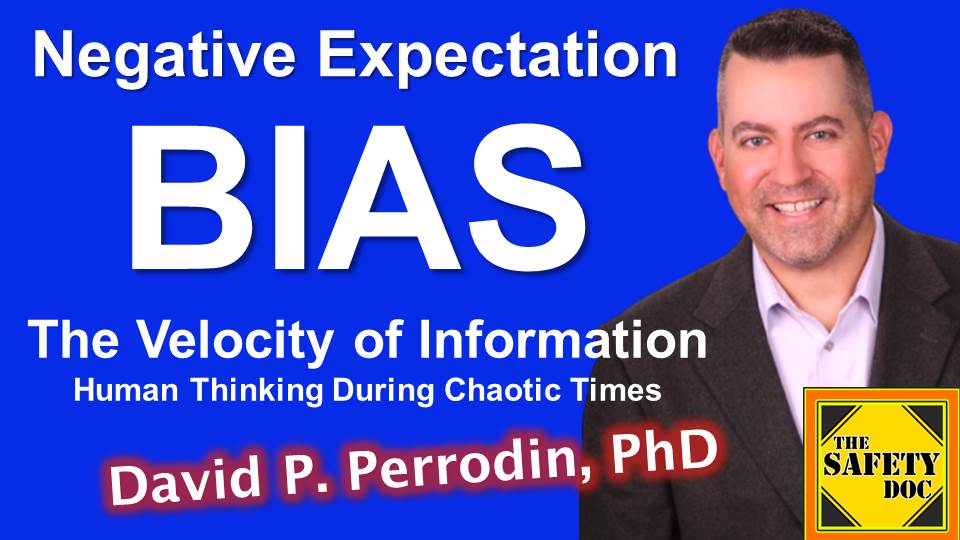Negative Expectation Bias | When All News is Bad News | The Velocity of Information | SDP181
[Podcast] A popular Reddit thread is titled, “What’s a ‘Today is going to suck’ red flag. A top up-voted response was, “Waking up with a huge headache,” and another was “When you get all the red lights on your commute.” Each of us could add a comment to that thread, right? Per the National Institute of Health, “Consistent with this focus, an anxiety-linked negative expectancy bias reflects an inflated tendency for anxious individuals to expect an increased probability of negative relative to positive events.” In other words, when people expect negative events, bad luck, or suboptimal outcomes – that’s what they will observe, and perceive, of the world around them. This frame of thinking might be accurate, but it is also damaging to morale if allowed to continue for long spans of time. In this episode, Doc will share his current observations of negative expectation bias, identifies times it has happened throughout history, and offers research-supported and anecdotal suggestions to mitigate the languishing impact of negative expectation bias. He will read related excerpts from his book, The Velocity of Information – Human Thinking During Chaotic Times (VOI).

DIRECT LINK to MP3 of this Episode: https://tinyurl.com/SDP181-AUDIO
WE SEEK AND ACCEPT EVIDENCE ALIGNED TO OUR BIASES. Per Psychology Today, “A bias is a tendency, inclination, or prejudice toward or against something or someone. Some biases are positive and helpful—like choosing to only eat foods that are considered healthy or staying away from someone who has knowingly caused harm. But biases are often based on stereotypes, rather than actual knowledge of an individual or circumstance. Whether positive or negative, such cognitive shortcuts can result in prejudgments that lead to rash decisions or discriminatory practices.” Our life experiences shape our biases, as do our families, as do our sources of information.
NORMALCY BIAS. One of the most-prominent biases in the safety community is normalcy bias – or the belief that an event isn’t severe enough to warrant a course-altering reaction. And, things will return to normal in a very short time. If this is how we think, then that’s how we will perceive the events that we observe in our world. People rooted to normalcy biases typically perform poorly during crisis situations. They fail to act, or the suddenly-changed context overwhelms them. They are slow to adapt. And, life and death is measured in the seconds between the onset of an emergency and one’s reaction to it.
FILTERING FOR NEGATIVE EXPECTATIONS. On the other hand, if we expect negative news, then we will perceive news as negative – or filter out neutral or positive news as it doesn’t match our expectation for bad news. It’s also remarkably hard to convince people that authentic events are not matched to their expectation bias. In other words, if you expect things to be good and they are, in fact, negative, you’ll have a predisposition to perceive things as good. Such a person might be happy and easy going, but they are also the last one into the lifeboat or out of the burning building.
MEDIA ABHORS IN A VACUUM. “The media abhors an information vacuum. It will take what information it has and amplify it, completing the ensemble with speculation when deemed necessary. Uncertainty makes us crave more information, so many people spend a lot of time looking for news updates, refreshing screens every few minutes to seek reassurance. As people lose proportion and perspective, they spiral down a whirlpool of confirmation (expectation) bias.” Pg. 50 of VOI.
MARTIAN ATTACK. “On October 28, 1938, many Americans believed they were being invaded by Martians. This erroneous belief was the result of a Halloween stunt orchestrated by Orson Welles in which he adapted H. G. Wells’s War of the Worlds to the radio and then broadcast the play as though it was actually happening. “[A] few short weeks before this broadcast, millions of listeners had kept their radios tuned for the latest news from a Europe apparently about to go to war.” Radio listeners therefore had a preexisting expectation bias toward catastrophically bad news. In the weeks that followed, Psychology professor Howard Cantril of Princeton University and colleagues interviewed people to try and understand their reactions to the broadcast. Of those that mistook the radio play as a live news report, almost none of them tuned to another station where they would have quickly found that life was completely normal.” Pg. 67 of VOI.
HOW TO LIMIT YOUR BIASES. Humans have biases – they are part of our survival wiring. Acknowledge when your biases are influencing your perceptions – you’ll probably be aware of this – more than you think. Listen to others’ perspectives. Vary your information sources.
This is episode 181 of The Safety Doc Podcast published on 05-10-2022. This podcast and blog post represent the opinions of David P. Perrodin and his guests to the show. The content here is for informational purposes only. Please consult with your safety professional regarding the unique needs of yourself or your organization.
FOLLOW
- Watch this episode on “The Safety Doc” YouTube channel https://tinyurl.com/SDP181-VIDEO
- Listen to this episode on PodBean MP3 https://tinyurl.com/SDP181-AUDIO
- Apple Podcasts http://tinyurl.com/SafetyDocApplePodcasts
- SAFETY DOC WEBSITE & BLOG safetyphd.com
- Follow David & The Safety Doc Podcast on Twitter @SafetyPhD
- Email Dr. Perrodin thesafetydoc@gmail.com
Purchase Dr. Perrodin’s books
School of Errors – Rethinking School Safety in America
The Velocity of Information – Human Thinking During Chaotic Times
